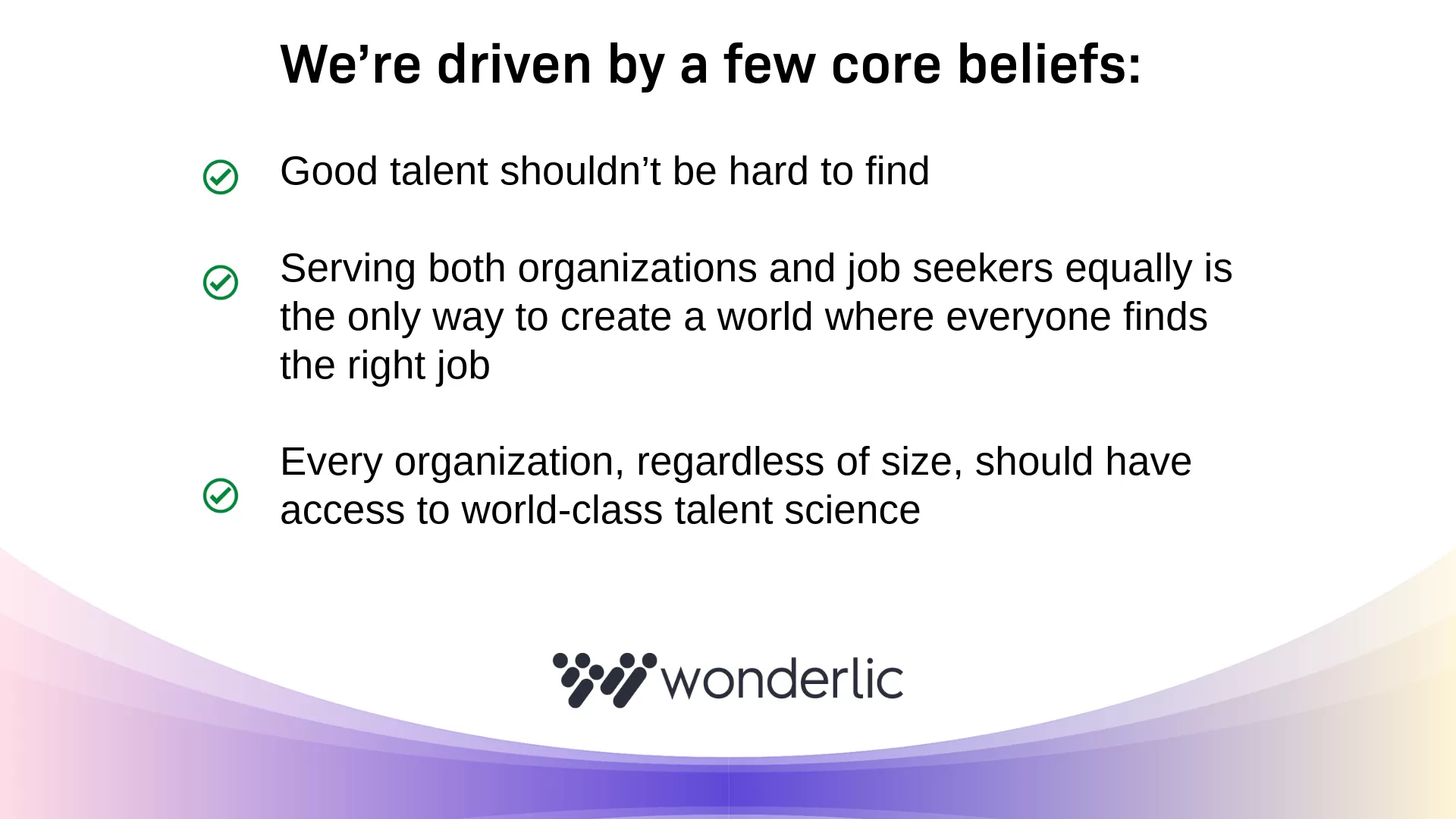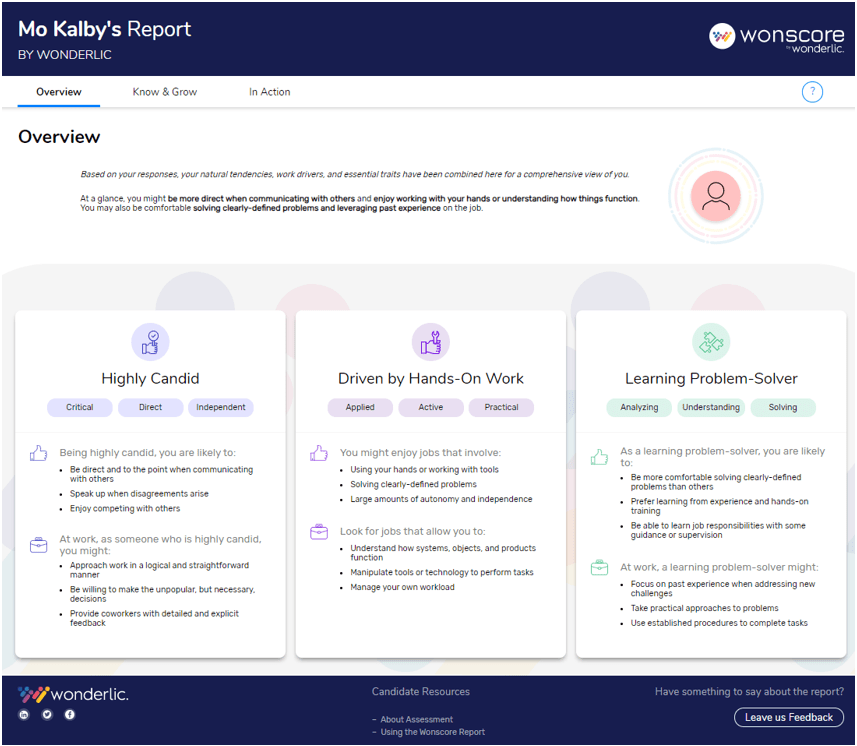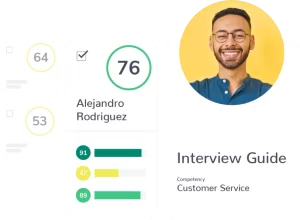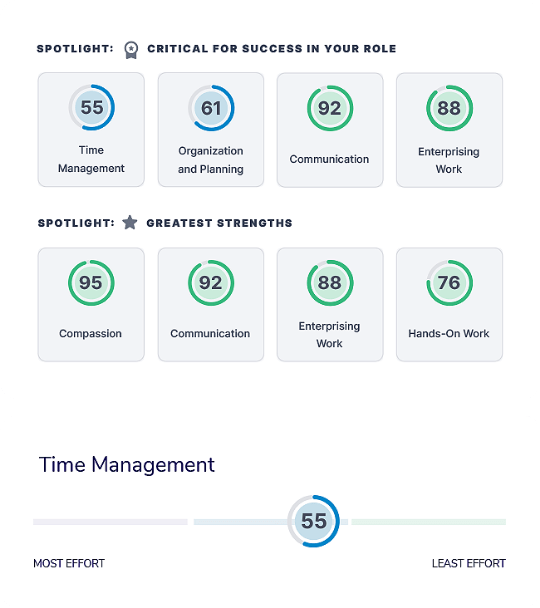
Discover 8 proven strategies to improve candidate experience—so you can attract, engage, and retain top talent in every stage of your hiring process.
Every touchpoint a candidate experiences leaves an impression. From stumbling upon a job ad on social media to getting a formal rejection email, a candidate is influenced by what they read, hear, and experience.
Candidates may think, “Wow, this company is on the ball and seems like a great place to work!" or they may think, "These people seem really slow at communicating. If this is the hiring candidate experience, what is it like to work for them?”
These first (and second, and third) impressions are often what make or break the decision to apply for or accept an eventual role.
So, when it comes to creating a positive hiring experience, what your organization does and doesn’t do can make all the difference in whether candidates eagerly apply for your positions or actively deter their peers from sending in their resumes.
But what creates a great candidate experience during recruitment? And what mistakes might you be making in your hiring strategies that cause candidates to look elsewhere?
This guide will help you understand how to improve the candidate experience when recruiting. You’ll discover common mistakes organizations make and learn candidate experience best practices to attract and retain top talent.
We'll cover:
- Why is the candidate experience important during recruitment?
- 8 ways to improve the candidate experience across recruitment and the hiring process
- Common mistakes that hurt the candidate experience during recruitment and hiring
- How Wonderlic helps improve the candidate experience
- Get a demo of Wonderlic
- FAQs: Candidate Experience
Why is the candidate experience important during recruitment?
Let’s start with a rhetorical question. Can a resume truly and fully capture a candidate's skills, experience, learning potential, and personality? The answer is no, not really.
Candidates today want to go beyond traditional resumes because they feel that a single sheet of paper doesn’t fully capture everything they bring to the table — their individuality and unique skill sets — and rightly so.
Because resumes attempt to summarize every job a candidate has ever had, along with employer details, roles, and responsibilities, they are severely limited. They don’t usually reflect a candidate's full range of skills, how well they work independently, how they fit into a team, the quality of their experience, their work ethic, their attention to detail, and more.
On top of that, demographics make a difference. Gen Z is expected to make up 30% of the workforce by 2025. While Gen Z is generally plugged in with excellent IT skills, older workers are typically less so. This means hiring managers need to adjust to enhance the candidate journey, making it as accessible as possible for everyone.
However, the traditional resume is still widely used in recruitment. Widespread consensus hasn’t evolved to accept more nuanced and personable ways of evaluating talent, creating a gap between what candidates want to express and how they’re able to express themselves.
The good news is that many companies are moving away from solely relying on traditional resumes and toward multi-measure assessments like Wonderlic.
Wonderlic’s multi-measure assessment lets recruiters quickly see a much more well-rounded view of candidates by measuring their cognitive ability, personality, and motivation in relation to an open role, thus enhancing the candidate experience.
The results of a positive recruitment experience
Candidates with a positive experience during recruitment are:
- More engaged employees. Considering that 77% of employees worldwide are not engaged at work, finding ways to increase engagement from the start of the hiring process sets the stage for higher job satisfaction and reduces problems down the line.
- Less likely to ghost their potential employer. Candidate ghosting is one of the top three recruitment challenges businesses face. When candidates feel respected and valued throughout the hiring process, they’re more willing to accept a job offer.
- More likely to become brand advocates. Even if they don’t get the job, candidates with positive experiences are more likely to positively share feedback about your company, recommend your company to others, or put your company on their radar to check out future positions.
Remember: A great candidate experience doesn’t stop at the job offer. It extends throughout onboarding, helping new hires feel welcomed and jumpstarting their path to success. When organizations have good communication processes and offer support at each step of recruitment, the candidate journey is enhanced, building trust weeks before a new hire starts.
The cost of a poor candidate experience
What job seekers think about and feel during their journey with a company — from the minute they see a job ad right through to the onboarding process or rejection stage — can either generate enthusiasm and excitement or frustrate them and make them feel undervalued.
Losing great applicants
Poor candidate experiences can push away good hires, leaving you with a bad or suboptimal pool of candidates. If you run a recruitment agency and have to hire a dud, the damage to your business relationships and reputation could be devastating.
"It takes 20 years to build a reputation and five minutes to ruin it. If you think about that, you'll do things differently."
Warren Buffett
Turnover and its cumulative costs
The effects of a poor candidate experience extend to financials. Bad hires contribute to 30% of new employees leaving within 90 days. If that happens, you have to kick off the whole recruitment process again. Worse, estimates put the cost of replacing an employee at six to nine months of an employee's salary.
Negative brand reputation
Did you know 75% of applicants consider an employer’s brand before applying? Having a strong and positive brand is tablestakes for effective recruitment. Not to mention, referrals generated by happy employees are one of the best ways to attract new talent. However, brand reputation is a double-edged sword, as a negative brand can turn away applicants and make referrals scarce, or worse, attract the wrong employees. Having a poor candidate experience is a surefire way to tarnish your brand’s reputation.
So, how can you improve the candidate experience so you don’t have to reap the consequences of a poor one?
8 ways to improve the candidate experience across recruitment & the hiring process
The best recruitment processes attract the talent you need and demonstrate a strong company culture. They exemplify the high standards your company strives for right from the start. Yet, despite knowing this, 74% of companies still struggle to find the talent they need.
However, you and your team can overcome these challenges with some clever planning and the right tools and strategies.
1. Make information easy to find
The number one obstacle candidates feel when searching for a job is not knowing what it’s like to work at an organization. Considering that 52% of job hunters use social media and a company’s website to find out more about a potential employer, it’s essential to show what kind of workplace you have.
By providing a transparent view of your workplace culture with information such as who’s who, your company vision and values, achievements to date, and what your company is working on, you give candidates the insights they need to feel confident applying.

Here are some ways you can enhance the candidate journey:
- Make it easy for candidates to find the information they need fast. Set up a dedicated careers page on your business website with employee testimonials and a sneak peek at what working for your company is like.
- Put names to faces. Send out a short video about the hiring team to introduce yourself to candidates. This video can also be a great place to reveal more about your workplace and company values.
Give applicants a simple way to contact the most appropriate person. This could be providing timely responses to candidates via email or having hiring managers open up their LinkedIn profiles for some back-and-forth dialogue with prospective applicants.
2. Develop clear job descriptions
Fuzzy job descriptions (JDs) confuse prospective employees and line managers when it comes to interviewing and managing their new employees on a daily basis. In fact, a recent poll on LinkedIn showed that 67% of recruiters, hiring managers, and candidates said that unclear JDs are a common barrier to job interviews.
What’s more, there’s a disconnect between what information hiring managers think is clear on a JD and what a candidate gleans. Three-quarters of hiring managers believe their JDs are clear enough, but just 36% of candidates agree with them.
Vague language, such as “competitive salary” and “self-starter,’ is open to broad interpretation. Pay and benefits should also be clearly defined. If you're looking for someone who works using their own initiative, spell that out rather than using terms like “self-starter,” which can mean different things to different people.
Instead of listing the job responsibilities and the education or experience required, think about the specific hard skills, soft skills, competencies, and traits the ideal candidate should have. Also, consider that many skills today are learnable, and (depending on the role) not everyone needs to have a decade of experience in a specific role.
Here are some ways you can create a positive candidate experience with clear JDs:
- Be ultra-specific about expectations and avoid sweeping statements that confuse or mislead candidates.
- Avoid the use of abbreviations. If you want to use them, spell out what they mean. Many abbreviations can have double meanings and add confusion. For example, HR can mean human resources or hourly rate!
- Highlight the qualifications and experience you need. Rather than stating “years of experience in accounting and finance,” put: “2 years of experience in auditing and preparing departmental budgets.” Make it clear which experiences are essential and which are “nice-to-haves.”
3. Reduce hurdles
65% of companies lose out on their best candidates because of lengthy hiring procedures.
Making candidates jump through hoops with hurdle after hurdle and interview after interview creates a poor candidate experience. Extensive online applications with numerous (and duplicative) fields to fill out, along with asking for additional documents like cover letters, evidence of qualifications, or work samples, can:
- Discourage the best candidates from applying
- Lengthen the application time
- Increase the chances of mistakes via typos or input errors
Errors can disqualify great candidates because they’ve unknowingly entered something wrong in the drawn-out process. By this time, a great candidate can be overlooked, or they may lose faith and drop out of the application process.
Here are some candidate experience best practices for reducing hurdles:
- Include clear instructions about the application process. Guide candidates through the entire process, from completing the application to the stages afterward and the timescales. This can help reduce confusion and minimize errors, leading to a smooth candidate experience.
- Reduce the number of fields on your application form. Do you need to ask for qualifications again if you’ve already asked for them on their resume?
- Simplify the application process with fewer steps. Consider combining initial candidate screenings and interviews into one session.
4. Improve communication via automation and mobile-friendly practices
Poor communication during the hiring process is frustrating for the recruiter and candidate. Providing conflicting information and having lengthy response times can cause them to lose interest.
With 35% of respondents identifying poor communication and responsiveness from potential employers as frustrating during their job search, candidate-centric recruitment practices that make communication easy can keep the hiring excitement high and the momentum going.
Even so, recruiters have to tackle changes in candidate communication preferences when hiring. Since over half of candidates now prefer to receive text messages to arrange an interview rather than an email or phone call, adapting to trends can sometimes help create a better candidate experience and maintain interest.
Here are some ways you can improve communication across your hiring processes:
- Use pre-hire assessments to understand candidate personalities and communication styles. Confident candidates are typically OK with a more assertive communication style, whereas less confident folks might need more constructive feedback.
- Evaluate your communication processes. Get feedback on how you give and receive candidate information to work out how to improve them for the next round of new hires (more on this later).
- Use automation to automatically schedule interviews, send important reminders, and coordinate other vital forms of communication.
5. Remove “free work/samples”
Yes, it takes time and effort to both apply for a job and review resumes. However, asking for free work to determine if someone is a good fit creates more barriers to entry for candidates, and worse, can become predatory when companies receive actual unpaid work under the guise of work samples.
Here are some ways you can still review candidates’ skills without asking for “free work:”
-
- Using pre-hire assessments to gain a comprehensive view of candidate fit. These assessments offer an objective way of allowing applicants to highlight their abilities and strengths without making them feel as though they’ve been taken advantage of with free work. Multi-measure assessments like Wonderlic Select use leading industrial-organizational psychology to measure cognitive ability, motivation, and personality relative to a specific role.
- Asking to see previous work. Often, a candidate’s portfolio can reveal the type and quality of work they’ll be able to deliver at your company. During the interview stage, you can also ask targeted questions about how they tackled past projects to gauge their problem-solving skills at a high level.
- Considering alternatives. If you really need to see how a candidate would tackle a specific project or task, paid assessments or paid sample projects can provide a more equitable way of revealing the type of work a candidate can create within certain parameters or with a certain prompt. Just make sure to pay market rate!
6. Make the candidate experience engaging
Your people are your greatest asset. When actively engaged, employees are more productive and motivated to do their best work. Yet, actively disengaged employees who oppose their employer’s goals make up 15% of the global workforce.
By engaging candidates in a fair and thoughtful hiring process, you increase the likelihood of applicants feeling respected. They’re also more likely to get a sense of your company culture, which will help them figure out if the role is the right fit.
So, even if they don’t land the job, they’re more likely to pass along the word of a great experience and become ambassadors for your organization.
Here are some ways you can make your candidate experience more engaging:
- Give candidates a way to showcase why they’d be a good fit for a role based on their experience, natural tendencies, and intrinsic capabilities. Wonderlic elevates the candidate experience beyond resumes, helping candidates feel that their whole self is being considered rather than judged solely on their experiences.
- Share assessment results as a thank you for participating. With Wonderlic, candidates receive their test results at the same time as recruiters, giving them critical insights into why they may or may not be a good fit for a role. This can help them work out where they excel and where they need to improve for future job applications.

7. Set realistic expectations
Did you know that 28% of candidates say the job-seeking process affects their mental health?
When candidates understand the timescales for shortlisting, it lowers their anxiety and helps them manage expectations with response times.
Candidates feel more in control of their job search when they know what to expect, reducing the stress of the unknown. And if they know what types of questions they’ll be asked, they can prepare their responses to showcase their unique experiences.
Set realistic expectations and help candidates feel prepared by:
- Providing a clear overview of the hiring process, with timelines and what to expect at each stage.
- Sending a list of interview questions to support candidates ahead of the meeting. Show what kind of company you are with transparency and professionalism.
8. Provide candidate feedback
Although a candidate has spent time and effort applying for a job, giving each applicant feedback can feel like a mammoth task. In reality, HR teams are already overloaded with posting jobs, reviewing resumes, scheduling and conducting interviews, and communicating with candidates and hiring managers.
According to a 2024 Sage report, a staggering 95% of HR leaders find their workloads stressful, and 89% are concerned that their team lacks enough resources.
But giving candidates insights about themselves can give them a better idea of what organizations are searching for and improve their future job applications. It makes their time spent applying worthwhile.
Automating candidate feedback reduces administrative burden. Wonderlic's candidate feedback report rewards candidates for the time spent on their assessments and reduces the risk of inconsistent feedback or candidate misunderstandings.
Easily share candidate feedback to show your appreciation while reducing administrative tasks by:
- Leveraging the right technology for the candidate experience. Provide value to candidates in exchange for their time spent completing Wonderlic Select assessments by automatically sending personal and detailed feedback.

Common mistakes that hurt the candidate experience during recruitment & hiring
According to Glassdoor, 38% of candidates are more likely to accept a job offer if they are satisfied with the application process.
Following the practical strategies we’ve listed above can improve the candidate experience, but make sure to avoid these common mistakes to better recruit, attract, and retain the best talent.
Unskilled hiring managers
Untrained managers create huge problems. They’re often promoted and thrown into the deep end without the proper skills and knowledge to motivate and manage employees. This is doubly true for untrained hiring managers. When they become involved in the hiring process, it may inadvertently show candidates that the company is unprofessional, unstructured, or disorganized.
For example, when one manager asks questions about soft skills and another about technical ability, it creates confusion. If candidates hear an HR manager talking badly about other departments or candidates, it signals a toxic work culture. Candidates often question whether they want to work at your company, influencing their decision to drop out of the hiring process.
When hiring managers don’t have the skills to carry out interviews professionally and with diversity and inclusion at the forefront of their minds, they can make unfair hiring decisions based on hunches or biases rather than objective data.
To overcome this, use standardized interview questions for every candidate and role. Wonderlic can help formalize your interview process with structured interview guides. In addition, consider offering workshops or PDF guides for hiring managers who will be communicating with candidates. This guide can include a list of dos and don’ts, along with helpful and instructive examples.

Restrictive application processes
Rigid hiring processes can be a sign of bureaucracy and show a need for more focus on the candidate experience. Inflexible practices like long-winded application forms and applications that aren’t accessible from a web browser can drive top talent away. It can also give job-seekers the impression that your company isn’t adaptable or employee-centric.
If we look at how today’s job-seekers find and apply for roles, around two-thirds of people use a mobile phone. Hiring software that isn’t mobile-friendly can leave even the best companies behind.
Give job-seekers the flexibility to complete their applications easily and conveniently and simplify the application process. With Wonderlic Select, candidates have access to a mobile-friendly experience, which opens up even more opportunities for candidates on all devices.
Constant rescheduling
Work is difficult enough without someone constantly changing goalposts. When hiring recruiters constantly cancel and rearrange interviews (or if they’re late for an interview and have to reschedule at the last minute), they add additional pressure and give off a sense of internal chaos.
Candidates may then question your company's reliability, creating anxiety and uncertainty. They’re left feeling like they’re not a priority, which is enough to make anyone run for the hills!
Respecting candidates’ time shows you value them and are committed to providing a positive hiring experience. Make sure interviews start and end on time. And if you do reschedule (life happens), explain why! That way, candidates are more likely to view your company positively, even during unexpected changes.
Poor onboarding
Onboarding can make or break your candidate experience. A complicated or rushed onboarding process can leave candidates feeling unsupported and like they’ve made the wrong decision, i.e., buyer’s remorse.
As 14% of candidates do not stay in their jobs after the first six months, good onboarding can improve employee retention rates. A study by The Wynhurst Group found that those who go through a structured onboarding program are 58% more likely to stay with the company for three years or more.
A well-structured and engaging onboarding process sets the tone for a new hire’s entire journey. It’s their first opportunity to experience your company culture and feel welcomed in their new position.
Show how you value a candidate’s unique strengths and don’t take a one-size-fits-all approach to onboarding. Customized tips for successful onboarding are a great way to keep your employees productive and engaged. These tips improve the candidate experience and are based on the information candidates provide. Even better, Wonderlic provides detailed information on candidates’ preferred learning and communication styles, helping you personalize the onboarding experience wherever applicable.

Silence is not golden
Silence can be frustrating, but transparency builds trust and respect. Provide the best possible experience to everyone who applies, and keep them in the loop with regular updates.
Because Wonderlic streamlines the entire communication process between the hiring manager and candidate, it keeps candidates and hiring managers informed about progress and any next steps.
What’s more, our multi-measure assessments look at candidates’ skills and interests, so the hard work is taken out of personalizing messages that match their profile. This means you can craft messages highlighting specific strengths revealed in the assessments to start building deep and meaningful connections.
So, instead of sending a generic “thanks for your application,” you can send a personalized communication, like, “Thanks for applying. Your strong leadership skills, as shown in your assessment, are exactly what we’re looking for.”
But here’s a reminder: Respectful companies give candidates reasonable time to make decisions, so avoid pushy follow-ups. Pressuring your chosen candidates to accept an offer can indicate desperation and rush them to make a decision, even if it’s the wrong one.
How Wonderlic enhances the candidate experience
Take the guesswork (and hard work) out of making the right hiring decisions with Wonderlic. Our award-winning software makes hiring easy AND gives candidates a top-notch experience.
Here’s how.
Wonderlic helps you predict candidate success
Hire the best candidate the first time, every time. Wonderlic Select assesses three predictors of job performance:
- Cognitive ability: Can your candidate do the job
- Personality: How will they do the job?
- Motivation: Do they want to do the job?
When you take these three factors into account, you hire not only someone with the right capabilities but also someone who aligns with your company's values and culture — someone who is inspired to stay for the long run.
But don’t take our word for it. Mike Mueller, an Employment Manager for 911 operators at Sedgwick County, said the Wonderlic test gives him peace of mind, knowing that making the right hiring choices will save lives.
“[Our] training director depends largely on the Wonderlic test to determine who is going to succeed and who isn’t. He looks seriously at it, relies heavily on it, and won’t recommend that we hire someone who doesn’t pass. It makes his job much, much easier.”
Wonderlic works with your existing tech stack
The benefit for candidates is that they don't have to switch between different apps to check their application progress. With Wonderlic, they take the assessment within the candidate portal, and their feedback report is automatically sent afterward. This streamlines the process, helping candidates stay engaged from the beginning.
Wonderlic provides instant access to assessment results
Wonderlic gives detailed, automatic candidate feedback. This means you can focus on other strategic hiring tasks rather than spending hours reviewing vast amounts of candidate information.
For example, our Candidate Feedback Report consists of three pages: Overview, Know & Grow, and In Action. The report provides varying information about a candidate’s performance and lightweight suggestions for the best use of their strengths.

Wonderlic helps employees take ownership of their careers
Wonderlic Develop helps employees grow and succeed in their roles by showing them their strengths and areas for improvement. Employees have access to clear pathways to enhance their performance. For example, the Spotlight Insights in Wonderlic help build employee self-awareness by highlighting what’s most important for a role and how an employee’s natural abilities match up.

Get a demo of Wonderlic
Regardless of whether a candidate gets hired, their experience throughout your hiring process should be a positive one, reflecting just how much your company values them. Creating a stellar candidate experience, from beginning to end, is how to improve the candidate experience in recruitment, leading to more engaged new hires and a sharper, more sought after brand.
Ready to give your candidates a better experience? Get started with a demo of Wonderlic today.
FAQs: Candidate Experience
How do I enhance the candidate experience?
First impressions count. Make the entire job-seeking process easy with simple tools and clear, timely communication. Keep candidates informed throughout every stage of the candidate journey, reflecting your company’s professionalism and respect for their time.
What is the simplest way to enhance the candidate experience?
Give candidates a feel for your culture by developing a clear and engaging job description. Highlight not just qualifications but also what makes someone a great fit.
Offer flexible interviewing options personalized to candidates’ preferences and needs.
Give meaningful candidate feedback. Help job-seekers understand their own strengths and areas for improvement and encourage them to take actionable steps.
How can I make my recruiting process better?
Use standardized interview questions for all candidates applying for the same position to improve the recruitment experience. Do your best to make fair and unbiased judgments about candidate skills, personality, and motivation levels by using additional and comprehensive screening tools like Wonderlic’s multi-measure assessment.
You can also personalize the experience by tailoring your outreach to candidates, using their names and referring to each candidate’s strengths. This signals you see and value them as individuals, not just applicants.
How can a recruiter improve their performance?
Work closely with departmental leaders to understand the skills and traits needed for success in vacant roles. This helps write clear job descriptions that meet the diverse needs of open positions and reduce the potential for problems with poor performance down the line.
You can also strengthen your company brand to attract top performers. Sharing real insights about your business — and what you’re striving to accomplish — across social media and your company website is a great place to start.
Weekly insights to hire smarter






